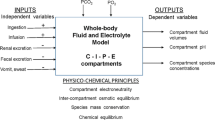Abstract
Objective: To identify clinical predictors of five abnormalities on the serum electrolyte panel and two abnormalities on the blood cell profile, to study which data elements carried predictive information, and to measure the predictive accuracy and stability of the resulting predictive equations.
Design: Prospective data collection from a computerized medical database supplemented by data entered by physicians who ordered outpatient tests into microcomputers. Equations were derived during an eight-month period and later validated twice in the same setting.
Setting: Academic primary care practice affiliated with a county hospital.
Patients and participants: Patients were mostly black women; physicians were full-time academic general internists and medical residents.
Measurements and main results: There were 6,570 electrolyte and blood cell profile panels ordered during the equation derivation period. The mean receiver operating characteristic (ROC) curve area for the seven equations was 0.849. For the 4,977 tests ordered during ten months of prospective validation, the mean ROC curve area was only 3% less. For three equations, ROC curve areas were lower for patients with unscheduled visits than for those with scheduled visits (p<0.05). Except for two equations involving abnormalities with very low prevalences, the equations were also well calibrated. Prior results for the abnormality being considered were the strongest predictors, followed by other laboratory results, diagnoses, and the physicians’ estimate of the probability that the test would be abnormal.
Conclusions: Clinical data can accurately predict abnormal results of common outpatient laboratory tests. Computers can help find the necessary data and produce estimates of risk.
Similar content being viewed by others
References
Sox HC: Probability theory in use of diagnostic tests. An introduction to critical study of the literature. Ann Intern Med. 1987;104:60–6.
Bushyhead JB, Christensen-Szalanski JJ. Feedback and the illusion of validity in a medical clinic. Med Decis Making. 1981;1:115–23.
Dolan JG, Bordley DR, Mushlin AI. An evaluation of clinicians’ subjective prior probability estimates. Med Decis Making. 1986;6:216–23.
Knaus WA, Draper EA, Wagner DP, Zimmerman JE. An evaluation of outcome from intensive care in major medical centers. Ann Intern Med. 1986;104:410–18.
Pollack MM, Ruttimann UE, Getson PR. Accurate prediction of the outcome of pediatric intensive care. N Engl J Med. 1987;316:134–9.
Bordley DR, Mushlin AI, Dolan JG, et al. Early clinical signs identify low-risk patients with acute upper gastrointestinal hemorrhage. JAMA. 1985;253:3282–6.
Pozen MW, D’Agostino RB, Selker HP, et al. A predictive instrument to improve coronary-care-unit admission practices in acute ischemic heart disease: a prospective multicenter clinical trial. N Engl J Med. 1984;310:1273–8.
Goldman L, Weinberg M, Weisberg M, et al. A computer-derived protocol to aid in the diagnosis of emergency room patients with acute chest pain. N Engl J Med. 1982;307:588–96.
Fishl MA, Pitchenik A, Gardner LB. An index predicting relapse and need for hospitalization in patients with acute bronchial asthma. N Engl J Med. 1981;305:783–9.
Maloney TW, Rogers DE. Medical technology — a different view of the contentious debate over costs. N Engl J Med. 1979;301:1413–19.
Dixon RH, Laszlo J. Utilization of clinical chemistry services by medical house staff: an analysis. Arch Intern Med. 1974;134:1064–7.
Olsen DM, Kane RL, Proctor PH. A controlled trial of multiphasic screening. N Engl J Med. 1976;294:925–30.
Daniels M, Schroeder SA. Variation among physicians in use of laboratory tests: II. Relation to clinical productivity and outcomes of care. Med Care. 1977;15:482–7.
Shapiro MF, Hatch RL, Greenfield S. Some containment and labor-intensive tests: the case of the leukocyte differential. JAMA 1984;252:231–4.
Hubbel FA, Greenfield S, Tyler JL, et al. The impact of routine admission chest x-ray films on patient care. N Engl J Med. 1985;312:209–13.
Kroenke K, Hanley JF, Copley JB, et al. The admission urinalysis: impact on patient care. J Gen Intern Med. 1986;1:238–42.
Tierney WM, McDonald CJ, Hui SL, Martin DK. Computer predictions of abnormal test results: effects on outpatient testing. JAMA 1988;259:1194–8.
McDonald CJ, Blevins L, Tierney WM, Martin DK. The Regenstrief medical records. MD Comput. 1988;5:34–47.
Tierney WM, McDonald CJ, Martin DK, Hui SL, Rogers MP. Computerized display of past test results: effects on outpatient testing. Ann Intern Med. 1987;107:569–74.
Tierney WM, McDonald CJ, McCabe GP. Serum potassium testing in diuretic-treated outpatients: a multivariate approach. Med Decis Making. 1985;5:89–104.
McDonald CJ, Hui SL, Tierney WM. Diuretic-induced laboratory abnormalities that predict ventricular ectopy. J Chronic Dis. 1986;39:127–35.
Hanley JA, McNeil BJ. The meaning and use of the area under a receiver operating characteristic (ROC) curve. Radiology. 1982;143:29–36.
Lemeshow S, Hosmer DW. A review of goodness of fit statistics for use in the development of logistic regression models. Am J Epidemiol. 1982;115:92–106.
Fineberg HV. Clinical chemistries: the high cost of low-cost diagnostic tests. In: Altman SH, Bierdon R, eds. Medical technology: the culprit behind health care costs? Washington, DC: U.S. Government Printing Office, 1979. DHEW Publication number (PHS) 79-3216.
Wilson GA, McDonald CJ, McCabe GP. The effect of immediate access to a computerized medical record on physician test ordering: a controlled clinical trial in the emergency room. Am J Public Health. 1982;72:698–702.
DeGroot MH, Feinberg SE. Assessing probability assessors: calibration and refinement. Stat Decis Theory Related Topics. 1982;1:291–315.
Author information
Authors and Affiliations
Additional information
Received from the Department of Medicine, Indiana University School of Medicine, the Regenstrief Institute for Health Care, and the Richard Roudebush Veterans Administration Medical Center, Indianapolis, Indiana.
Supported by research grants HS-04996 and HS-05626 from the National Center for Health Services Research and Technology Assessment, DHHS.
Rights and permissions
About this article
Cite this article
Tierney, W.M., Martin, D.K., Hui, S.L. et al. Using clinical data to predict abnormal serum electrolytes and blood cell profiles. J Gen Intern Med 4, 375–383 (1989). https://doi.org/10.1007/BF02599685
Issue Date:
DOI: https://doi.org/10.1007/BF02599685




